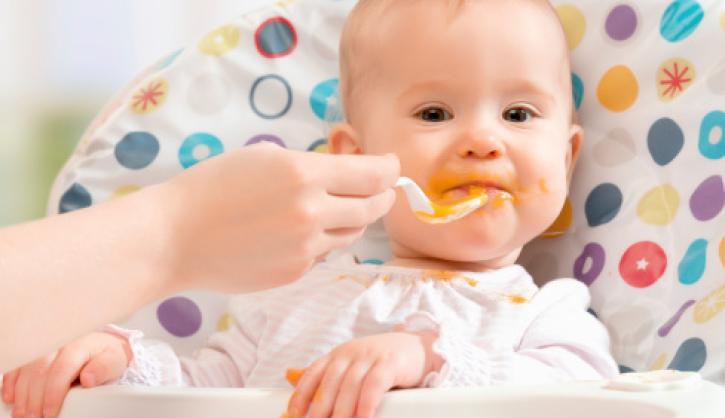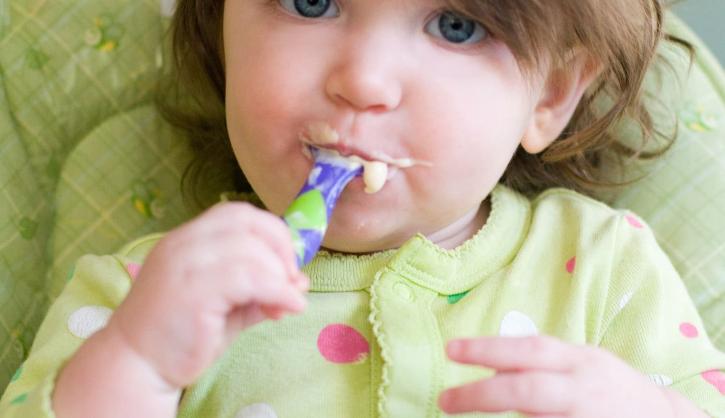Growing up milestones
- Might start crawling
- Will pull himself up
- First teeth begin to appear
- May start to feed himself
- Knows his name
- Starts saying ‘dada’ and ‘mama’
- Shows you if happy or scared
Daily requirements (825-920 kcal/day)
- Breast milk (or follow-on formula):
What?
Breast milk, on demand. If you choose to use a follow-on formula, please follow the advice of your health care professional and the on-pack feeding and preparation guidelines.
Why?
Breast milk or formula milk is still the main source of nutrients for your weaning baby. From 6 to 12 months your baby needs the equivalent of 500-600 ml of milk a day, which is about a pint.
As your baby grows, they’ll begin to need more iron, which they will need to get from solid foods. (Your health care professional will be able to advise you in more detail.)
- Infant cereals (50- 00 g):
What?
Your baby will eat about 50-100g or 3-6 tablespoons of iron fortified infant cereal a day.
Why?
Each serving of infant cereal is packed with important nutrients and provides complex carbohydrates that are easy to digest. This makes them an ideal food for babies who still only have little tummies, and will help them feel fuller for longer.
- Fruits (130 – 260g):
What?
Your baby needs about 8-15 tablespoons per day of puréed fruit (1-2 medium sized apples).
Why?
Fruit contains vitamins, minerals, antioxidants (to help keep cells healthy), and gentle dietary fibre (to help support digestion).
- Vegetables (130 - 260g):
What?
Your baby will need about 8-15 tablespoons per day of puréed vegetables.
Why?
Vegetables contain vitamins, minerals, antioxidants (to help keep cells healthy), and gentle dietary fibre (to help support digestion).
- Meat & Fish (15 - 30g):
What?
1-2 tablespoons of cooked and puréed meat, fish or scrambled egg per day.
Why?
This amount of meat, fish or egg provides high quality protein (needed for building little muscles). Red meat is a great source of iron. Oily fish, such as salmon and tuna, contain essential fatty acids such as omega 3. Oily fish is also good for mental development.
Eating skills
- He loves to practise chomping and chewing: Give him chewier and chunkier textures to practise on.
- He can hold a spoon: Once he can find his mouth with it, he’s ready to start feeding himself. A small bowl of cereal or puréed fruit is the perfect place for him to start.
- His first teeth are beginning to break through: It’s a good time to help him take his first bites.
- He begins to pick up food with thumb and forefinger: Provide different sized pieces of bright coloured vegetables to encourage him to pick them up.
How much is too much?
Your baby can help you understand how much food he needs. You just have to learn his cues.
Your baby might have had enough if he:
- Shakes head to say ‘no more’
- Bats, pushes or drops the bowl
- Clamps lips shut, stops opening mouth or closes eyes
- Gets distracted easily
- Spits out familiar food or pushes it away
Full up – suggestions
Learn to understand your baby’s cues. If they are full, don’t try to force them to eat more. It’s normal for the amount your baby eats to change from meal to meal as well as day to day depending on their activity level.
Keep a food diary. You’ll be able to see what, how much and when they like to eat, and it’s a handy reference for talking to your health care professional, if ever needed.
Your baby may still be hungry if he:
- Opens mouth for food or spoon
- Reaches out for food
- Gets excited about eating
- Follows you with his eyes or looks at food while eating
Still hungry – suggestions
After the meal, offer 1-4 teaspoons of infant cereals, fruit or vegetables. You can try to gradually increase the number of teaspoons of infant cereals, fruit, vegetables, meat or fish at the next mealtime by 1-4 teaspoons.
They could also be thirsty. Try offering them some water to drink.
Try offering them a teething biscuit or a small piece of bread. It will also help them practise their chewing.
Foods to enjoy
Although breast milk and/or follow on formula are still important, a healthy balanced diet is key. All the major food groups now have a big role to play.
- Dairy products:
Pasteurised soft cheeses, yogurt and custard are good sources of protein and calcium – an important building block for bones.
- Cereals:
Due to its complex carbohydrates, pasta is a great source of energy. Cook it until it’s melt in the mouth soft (much softer than you’d normally serve for grown-ups). It will help them practise their chewing.
- Vegetables:
Asparagus, turnip, beetroot, green beans, pepper and okra are packed with vitamins, minerals and antioxidants and provide plenty of gentle fibre. Steaming is the best way to preserve their vitamins and taste. Adding a little good quality vegetable oil will help your baby to better absorb certain vitamins.
- Herbs and spices:
Coriander, garlic, mint, vanilla, thyme and parsley – add just a sprinkle to give him new tastes and flavours.
- Fruits:
Mango, pineapple, coconut, rhubarb, melon and figs are packed with vitamins, minerals, antioxidants and provide plenty of gentle dietary fibre. They will provide new exciting tastes and textures.
- Meat, Fish and Eggs:
Like meat and fish, eggs can provide your baby with high quality protein. Egg yolks are also a good source of vitamins. Remember to ensure that the egg is fully cooked and the yolk is not runny.











